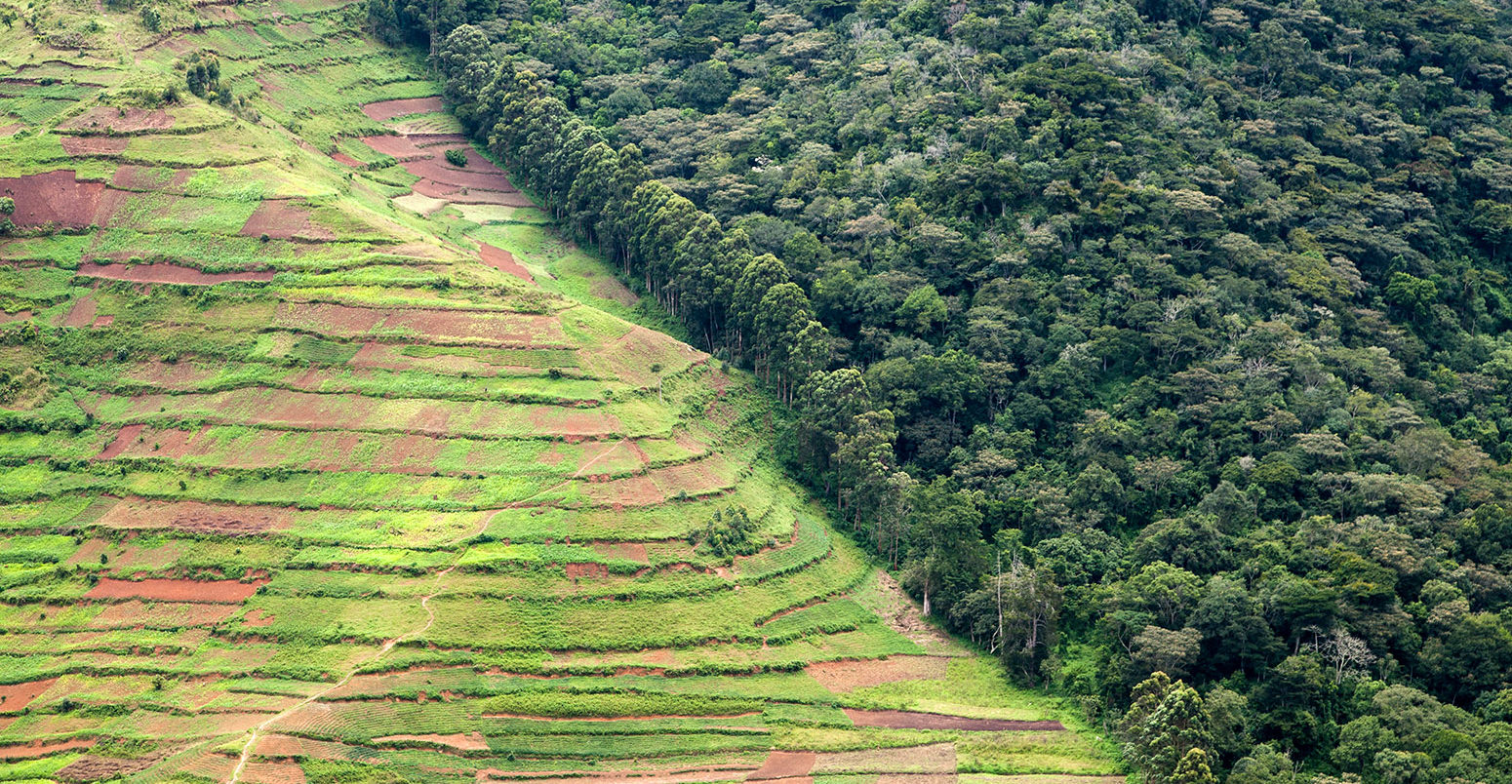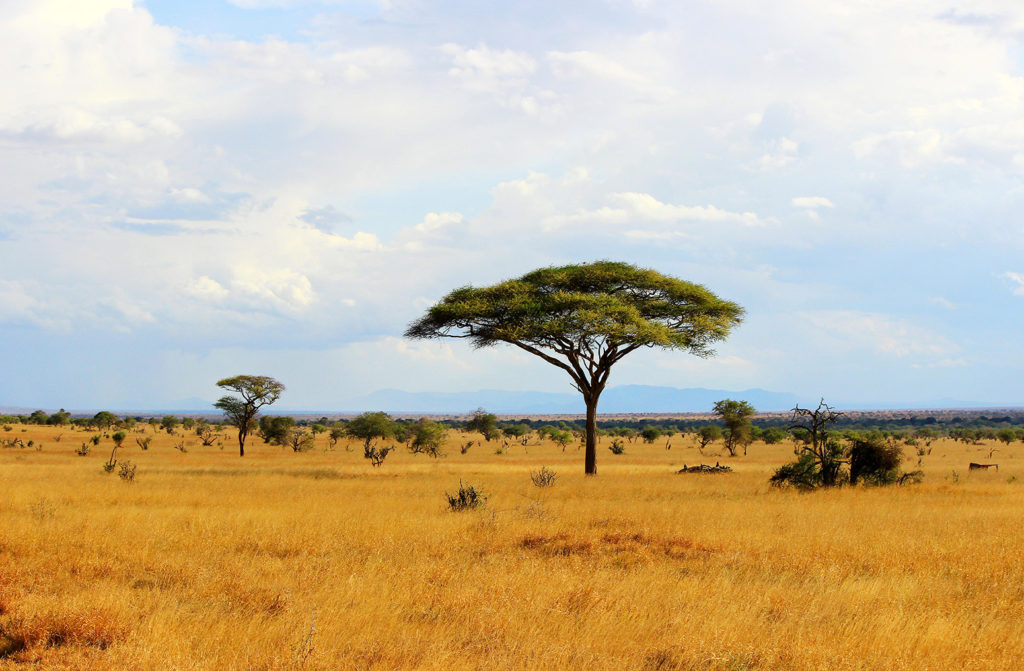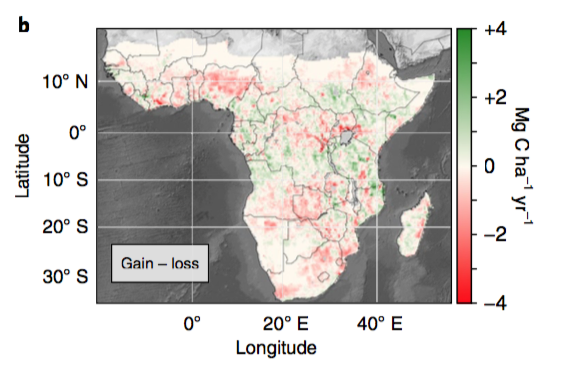
Africa’s vegetation has lost 2.6bn tonnes of CO2 in just seven years
Daisy Dunne
04.09.18Daisy Dunne
09.04.2018 | 4:00pmThe rainforests, savannahs and woodlands of sub-Saharan Africa have lost around 2.6bn tonnes of CO2 over the past seven years, a new study finds.
The large-scale loss of stored carbon – which on an annual basis is almost four times the CO2 emissions of Nigeria – was driven by a series of severe droughts across the continent, as well as deforestation, the research suggests.
The results were gathered using a novel satellite technique, which allowed researchers to measure “deeper below the vegetation canopy” than ever before, the lead author tells Carbon Brief.
Blank canvas
The world’s trees, plants and shrubs are capable of storing large amounts of carbon. This is because they absorb carbon from the atmosphere during photosynthesis and then use it to grow new leaves, shoots and roots.
However, vegetation can also release large amounts of carbon into the atmosphere. This can be caused by deforestation as well as climate-related factors, such as drought and wildfires.
Africa holds one third of the world’s tropical rainforests. On top of this, 50% of the continent’s surface is covered by savannah – grasslands with sparsely distributed trees – and woodlands, forested areas that fall outside of humid zones. Despite this, data on the total amount of carbon held by African vegetation is scant.
The new study, published in Nature Ecology and Evolution, aims to provide an overview of how sub-Saharan Africa’s vegetation carbon stocks changed between 2010 and 2016.
It finds that Africa’s green regions experienced an overall loss of 2.6bn tonnes of CO2 in the past seven years, with yearly losses averaging at 367m tonnes of CO2.
Carbon losses occurred across a range of ecosystems, including rainforests, savannahs and woodlands, explains lead author Dr Martin Brandt from the University of Copenhagen. He tells Carbon Brief:
“We find that severe droughts have caused huge carbon losses which are not restricted to rainforests but also happened in savannahs. Over the full period, losses in savannahs and woodlands were almost as high as in rainforests.”

African savannah landscape in Tsavo Park, Kenya. Credit: Maciej Czekajewski / Alamy Stock Photo.
Continental carbon
To understand changes in carbon on a continental scale, the research team used satellites to capture changes to tree cover from 2010-16.
The technique, which is known as “L-VOD”, uses low-frequency microwaves rather than high-resolution photographs, which are usually used to measure changes to forest cover.
This approach means satellite measurements are less likely to obscured by cloud cover and the upper reaches of the forest canopy, explains Brandt:
“[This method] is insensitive to clouds and almost insensitive to green vegetation, which allows the signal to sense deeper below the vegetation canopy and assess almost the entire vegetation layer including stems and branches.
“So the satellite is able to measure the water content of all vegetation, no matter how dense, and this can be used to estimate the biomass for both forests and savannahs.”
The results of the data collection are displayed on the map below, which shows changes to net carbon density across sub-Saharan Africa from 2010-16. On the map, green shows carbon density gain while red signifies loss.

Changes to carbon density of vegetation across sub-Saharan Africa from 2010-16. Green shows gain while red signifies loss. Source: Brandt et al. (2018)
The maps show that, across sub-Saharan Africa, the amount of land experiencing a net drop in carbon density was larger than the amount of land experiencing net gains.
The countries experiencing the largest drop in carbon stocks included Ghana, the Ivory Coast, Nigeria, Uganda and Kenya.
Damaging drought
Declines in carbon stocks were largely driven by periods of prolonged drought occurring across the continent over the course of the study period, Brandt says.
His research finds that large regional declines in carbon stocks were closely related to particularly dry spells over the past seven years, which were in part driven by a natural weather phenomenon known as El Niño. He says:
“Natural factors clearly dominated over this period as much larger regions were affected – and the droughts in 2015 were extreme.”
Periods of drought can quickly kill off large numbers of trees, causing the carbon stored within their leaves, trunk and branches to be released back into the atmosphere.
Although El Niño is a natural event, research suggests that climate change could make “extreme” events more frequent. This means that drought could become a more prominent driver of carbon loss as the climate warms.
Deforestation in tropical regions may have also played a role in carbon stock decline, Brandt adds:
“Human factors were observed more locally in rainforest areas but not clear in savannahs.”
Despite frequent drought, a number of countries experienced a net gain in carbon density, including Sudan and the Central African Republic, Brandt says:
“Climate plays a role, but the gains are much higher than one would expect. Migration to urban areas, land abandonment, conflicts and a decrease in wood gathering may play a role [in carbon density gains].”
Forest forecast
The findings highlight how climate change could play a role in accelerating carbon loss in African rainforests, woodlands and savannahs, the paper says:
“If dry years become more frequent, large-scale carbon losses may exacerbate climate change, particularly in dry areas.”
The results highlight the need for more consistent and frequent monitoring of Africa’s carbon stocks, the paper concludes:
“Our study therefore highlights the importance of timely monitoring of both tropical deforestation and the highly dynamic woody carbon stocks of savannah ecosystems for assessments of global carbon stocks.”
Brandt, M. et al. (2018) Satellite passive microwaves reveal recent climate-induced carbon losses in African drylands, http://nature.com/articles/doi:10.1038/s41559-018-0530-6
-
Africa’s vegetation has lost 2.6bn tonnes of CO2 in just seven years
-
Africa’s forests and savannahs lost 2.6bn tonnes of CO2 in seven years

